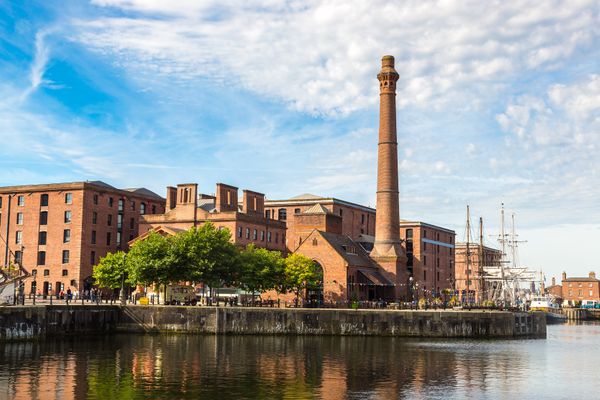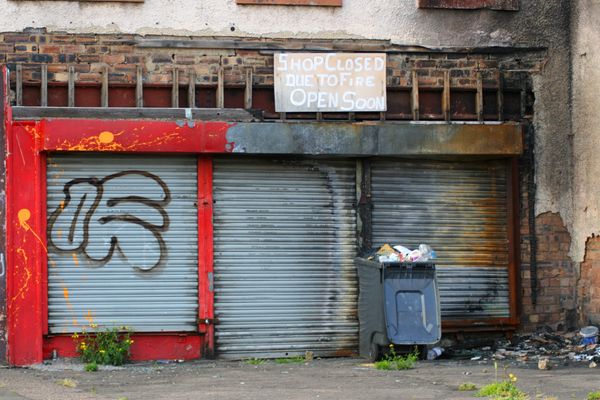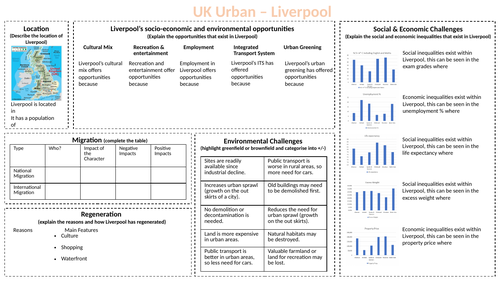Case Study: Urban Change in Liverpool
An overview of liverpool.
Liverpool is a port on the north-west coast of England. It is built upon the estuary of the River Mersey and is close to Manchester.


What is the importance of Liverpool?
- Liverpool's port was a hub for trade with the United States of America and was an important shipping port in the slave trade.
- Cotton prices in England were benchmarked by the prices that were available in the market by Liverpool's port.
- Liverpool is home to Liverpool Football Club (and Everton).

Impacts of national migration on Liverpool
- Liverpool has populations with strong origins from Wales and Ireland.
- The Irish potato famine of 1845-1849 led many to sail across the Irish Sea to Liverpool.
- Liverpool is on the border of Wales, so there is also a strong Welsh contingent in Liverpool.
- In 2019, there were estimates that 3/4 of Liverpool's population had Irish heritage of some kind.

Impacts of international migration on Liverpool
- Liverpool's port has been a trading hub with the world for many years.
- People who come from Liverpool are known as Scousers and have a strong accent, distinctive to many other parts of the UK.
- The decline of the UK's physical manufacturing industries has hurt Liverpool's economic wellbeing as there are fewer physical goods to export via ship.
- International migration has helped Liverpool to end their Premier League title drought, with Mohammed Salah, Sadio Mane, and Roberto Firmino migrating from Egypt, Senegal, and Brazil to improve a weak strike force.
Opportunities Created by Urban Change in Liverpool
Liverpool's transition from a thriving port and manufacturing hub towards a tourist destination and creative industry hub has led to the following opportunities:

Social opportunities
- The migration has created more ethnic diversity and more diversity of opinion in Liverpool.
- Recreation and entertainment have improved and international migration now allows Liverpool Football Club to beat everyone, instead of losing with Daniel Sturridge and Christian Benteke playing up front.
- The Albert Dock in Liverpool has become a cultural hub, home to museums, docks, restaurants, and bars.

Economic opportunities
- Liverpool John Lennon Airport has become a transport hub for the north of England and Easyjet has lots of cheap flights flying out of the airport every day.
- Merseytravel is a single business that operates all of Liverpool's transport infrastructure, making it very convenient for customers.
- In 2018, 494,000 people lived in Liverpool and only 4.2% of people were unemployed.

Environmental opportunities
- Urban greening involves turning brown belt sites or wasteland in cities into green spaces like parks.
- The Liverpool ONE development included a brand new park in Liverpool City Centre.
Challenges Created by Urban Change in Liverpool
Liverpool's decline from a thriving port in the 1800s, to a struggling area from 1950 to a new tourist destination with creative industries has created new problems for the city.

Social and economic challenges
- As with many cities, inequality grows as the city gets larger.
- Parts of Liverpool like Croxteth and Anfield are dominated by council housing and low income residents.
- There is great inequality between people living in these areas and those living in brand new developments in the new Beetham Tower.
- People in the less advantaged areas often perform worse in school, have a lower life expectancy and are more likely to become unemployed in the future.

Environmental challenges
- In 2019, 22 green belt sites in the Wirral were protected from development. Although the projects did not go ahead, this shows the pressure to build on green belt land when a city is growing quickly.
- Newsham Park Asylum and the Liverpool Fruit Exchange are now derelict, unused buildings. However, these buildings are also opportunities for redevelopment.
- In 2014, a local newspaper report claimed that Liverpool did not have enough capacity to recycle all the relevant materials, so lots of things that could be recycled were put in landfill sites instead.
1 The Challenge of Natural Hazards
1.1 Natural Hazards
1.1.1 Types of Natural Hazards
1.1.2 Hazard Risk
1.1.3 Consequences of Natural Hazards
1.1.4 End of Topic Test - Natural Hazards
1.1.5 Exam-Style Questions - Natural Hazards
1.2 Tectonic Hazards
1.2.1 Tectonic Plates
1.2.2 Tectonic Plates & Convection Currents
1.2.3 Plate Margins
1.2.4 Volcanoes
1.2.5 Effects of Volcanoes
1.2.6 Responses to Volcanic Eruptions
1.2.7 Earthquakes
1.2.8 Earthquakes 2
1.2.9 Responses to Earthquakes
1.2.10 Case Studies: The L'Aquila & Kashmir Earthquakes
1.2.11 Earthquake Case Study: Chile 2010
1.2.12 Earthquake Case Study: Nepal 2015
1.2.13 Living with Tectonic Hazards 1
1.2.14 Living with Tectonic Hazards 2
1.2.15 End of Topic Test - Tectonic Hazards
1.2.16 Exam-Style Questions - Tectonic Hazards
1.2.17 Tectonic Hazards - Statistical Skills
1.3 Weather Hazards
1.3.1 Global Atmospheric Circulation
1.3.2 Surface Winds
1.3.3 UK Weather Hazards
1.3.4 Tropical Storms
1.3.5 Features of Tropical Storms
1.3.6 Impact of Tropical Storms 1
1.3.7 Impact of Tropical Storms 2
1.3.8 Tropical Storms Case Study: Katrina
1.3.9 Tropical Storms Case Study: Haiyan
1.3.10 UK Weather Hazards Case Study: Somerset 2014
1.3.11 End of Topic Test - Weather Hazards
1.3.12 Exam-Style Questions - Weather Hazards
1.3.13 Weather Hazards - Statistical Skills
1.4 Climate Change
1.4.1 Evidence for Climate Change
1.4.2 Causes of Climate Change
1.4.3 Effects of Climate Change
1.4.4 Managing Climate Change
1.4.5 End of Topic Test - Climate Change
1.4.6 Exam-Style Questions - Climate Change
1.4.7 Climate Change - Statistical Skills
2 The Living World
2.1 Ecosystems
2.1.1 Ecosystems
2.1.2 Ecosystem Cascades & Global Ecosystems
2.1.3 Ecosystem Case Study: Freshwater Ponds
2.2 Tropical Rainforests
2.2.1 Tropical Rainforests - Intro & Interdependence
2.2.2 Adaptations
2.2.3 Biodiversity of Tropical Rainforests
2.2.4 Deforestation
2.2.5 Case Study: Deforestation in the Amazon Rainforest
2.2.6 Sustainable Management of Rainforests
2.2.7 Case Study: Malaysian Rainforest
2.2.8 End of Topic Test - Tropical Rainforests
2.2.9 Exam-Style Questions - Tropical Rainforests
2.2.10 Deforestation - Statistical Skills
2.3 Hot Deserts
2.3.1 Overview of Hot Deserts
2.3.2 Biodiversity & Adaptation to Hot Deserts
2.3.3 Case Study: Sahara Desert
2.3.4 Desertification
2.3.5 Case Study: Thar Desert
2.3.6 End of Topic Test - Hot Deserts
2.3.7 Exam-Style Questions - Hot Deserts
2.4 Tundra & Polar Environments
2.4.1 Overview of Cold Environments
2.4.2 Adaptations in Cold Environments
2.4.3 Biodiversity in Cold Environments
2.4.4 Case Study: Alaska
2.4.5 Sustainable Management
2.4.6 Case Study: Svalbard
2.4.7 End of Topic Test - Tundra & Polar Environments
2.4.8 Exam-Style Questions - Cold Environments
3 Physical Landscapes in the UK
3.1 The UK Physical Landscape
3.1.1 The UK Physical Landscape
3.2 Coastal Landscapes in the UK
3.2.1 Types of Wave
3.2.2 Weathering & Mass Movement
3.2.3 Processes of Erosion & Wave-Cut Platforms
3.2.4 Headlands, Bays, Caves, Arches & Stacks
3.2.5 Transportation
3.2.6 Deposition
3.2.7 Spits, Bars & Sand Dunes
3.2.8 Case Study: Landforms on the Dorset Coast
3.2.9 Types of Coastal Management 1
3.2.10 Types of Coastal Management 2
3.2.11 Coastal Management Case Study - Holderness
3.2.12 Coastal Management Case Study: Swanage
3.2.13 Coastal Management Case Study - Lyme Regis
3.2.14 End of Topic Test - Coastal Landscapes in the UK
3.2.15 Exam-Style Questions - Coasts
3.3 River Landscapes in the UK
3.3.1 The River Valley
3.3.2 River Valley Case Study - River Tees
3.3.3 Erosion
3.3.4 Transportation & Deposition
3.3.5 Waterfalls, Gorges & Interlocking Spurs
3.3.6 Meanders & Oxbow Lakes
3.3.7 Floodplains & Levees
3.3.8 Estuaries
3.3.9 Case Study: The River Clyde
3.3.10 River Management
3.3.11 Hard & Soft Flood Defences
3.3.12 River Management Case Study - Boscastle
3.3.13 River Management Case Study - Banbury
3.3.14 End of Topic Test - River Landscapes in the UK
3.3.15 Exam-Style Questions - Rivers
3.4 Glacial Landscapes in the UK
3.4.1 Erosion
3.4.2 Landforms Caused by Erosion
3.4.3 Landforms Caused by Transportation & Deposition
3.4.4 Snowdonia
3.4.5 Land Use in Glaciated Areas
3.4.6 Tourism in Glacial Landscapes
3.4.7 Case Study - Lake District
3.4.8 End of Topic Test - Glacial Landscapes in the UK
3.4.9 Exam-Style Questions - Glacial Landscapes
4 Urban Issues & Challenges
4.1 Urban Issues & Challenges
4.1.1 Urbanisation
4.1.2 Urbanisation Case Study: Lagos
4.1.3 Urbanisation Case Study: Rio de Janeiro
4.1.4 UK Cities
4.1.5 Case Study: Urban Regen Projects - Manchester
4.1.6 Case Study: Urban Change in Liverpool
4.1.7 Case Study: Urban Change in Bristol
4.1.8 Sustainable Urban Life
4.1.9 End of Topic Test - Urban Issues & Challenges
4.1.10 Exam-Style Questions - Urban Issues & Challenges
4.1.11 Urban Issues -Statistical Skills
5 The Changing Economic World
5.1 The Changing Economic World
5.1.1 Measuring Development
5.1.2 Classifying Countries Based on Wealth
5.1.3 The Demographic Transition Model
5.1.4 Physical & Historical Causes of Uneven Development
5.1.5 Economic Causes of Uneven Development
5.1.6 How Can We Reduce the Global Development Gap?
5.1.7 Case Study: Tourism in Kenya
5.1.8 Case Study: Tourism in Jamaica
5.1.9 Case Study: Economic Development in India
5.1.10 Case Study: Aid & Development in India
5.1.11 Case Study: Economic Development in Nigeria
5.1.12 Case Study: Aid & Development in Nigeria
5.1.13 Economic Development in the UK
5.1.14 Economic Development UK: Industry & Rural
5.1.15 Economic Development UK: Transport & North-South
5.1.16 Economic Development UK: Regional & Global
5.1.17 End of Topic Test - The Changing Economic World
5.1.18 Exam-Style Questions - The Changing Economic World
5.1.19 Changing Economic World - Statistical Skills
6 The Challenge of Resource Management
6.1 Resource Management
6.1.1 Global Distribution of Resources
6.1.2 Food in the UK
6.1.3 Water in the UK 1
6.1.4 Water in the UK 2
6.1.5 Energy in the UK
6.1.6 Resource Management - Statistical Skills
6.2.1 Areas of Food Surplus & Food Deficit
6.2.2 Food Supply & Food Insecurity
6.2.3 Increasing Food Supply
6.2.4 Case Study: Thanet Earth
6.2.5 Creating a Sustainable Food Supply
6.2.6 Case Study: Agroforestry in Mali
6.2.7 End of Topic Test - Food
6.2.8 Exam-Style Questions - Food
6.2.9 Food - Statistical Skills
6.3.1 The Global Demand for Water
6.3.2 What Affects the Availability of Water?
6.3.3 Increasing Water Supplies
6.3.4 Case Study: Water Transfer in China
6.3.5 Sustainable Water Supply
6.3.6 Case Study: Kenya's Sand Dams
6.3.7 Case Study: Lesotho Highland Water Project
6.3.8 Case Study: Wakel River Basin Project
6.3.9 Exam-Style Questions - Water
6.3.10 Water - Statistical Skills
6.4.1 Global Demand for Energy
6.4.2 Factors Affecting Energy Supply
6.4.3 Increasing Energy Supply: Renewables
6.4.4 Increasing Energy Supply: Non-Renewables
6.4.5 Carbon Footprints & Energy Conservation
6.4.6 Case Study: Rice Husks in Bihar
6.4.7 Exam-Style Questions - Energy
6.4.8 Energy - Statistical Skills
Jump to other topics

Unlock your full potential with GoStudent tutoring
Affordable 1:1 tutoring from the comfort of your home
Tutors are matched to your specific learning needs
30+ school subjects covered
Case Study: Urban Regen Projects - Manchester
Case Study: Urban Change in Bristol
- Search Menu
- Browse content in Arts and Humanities
- Browse content in Archaeology
- Historical Archaeology
- Browse content in Classical Studies
- Classical Philosophy
- Classical Literature
- Religion in the Ancient World
- Browse content in History
- Colonialism and Imperialism
- History by Period
- Intellectual History
- Maritime History
- Military History
- Political History
- Regional and National History
- Slavery and Abolition of Slavery
- Social and Cultural History
- Theory, Methods, and Historiography
- Linguistics
- Browse content in Literature
- Literary Studies (European)
- Literary Studies (Romanticism)
- Literary Studies (American)
- Literary Studies - World
- Literary Studies (1500 to 1800)
- Literary Studies (19th Century)
- Literary Studies (20th Century onwards)
- Literary Studies (African American Literature)
- Literary Studies (Early and Medieval)
- Literary Studies (Fiction, Novelists, and Prose Writers)
- Literary Studies (Plays and Playwrights)
- Literary Studies (Poetry and Poets)
- Literary Studies (Women's Writing)
- Literary Theory and Cultural Studies
- Mythology and Folklore
- Browse content in Media Studies
- Browse content in Music
- Music Theory and Analysis
- Musical Structures, Styles, and Techniques
- Musicology and Music History
- Browse content in Religion
- History of Religion
- Judaism and Jewish Studies
- Religion and Art, Literature, and Music
- Religious Studies
- Browse content in Society and Culture
- Cultural Studies
- Visual Culture
- Browse content in Science and Mathematics
- History of Science and Technology
- Browse content in Social Sciences
- Browse content in Business and Management
- Business Strategy
- Business History
- Browse content in Economics
- Economic History
- Museums, Libraries, and Information Sciences
- Browse content in Politics
- Environmental Politics
- International Relations
- Political Sociology
- Political Theory
- Public Policy
- UK Politics
- Browse content in Regional and Area Studies
- African Studies
- Asian Studies
- Latin American Studies
- Middle Eastern Studies
- Browse content in Sociology
- Gender and Sexuality
- Migration Studies
- Occupations, Professions, and Work
- Social Movements and Social Change
- Sport and Leisure
- Urban and Rural Studies
- Reviews and Awards
- Journals on Oxford Academic
- Books on Oxford Academic

- < Previous chapter
- Next chapter >
3. Urban Regeneration, Politics and Social Cohesion: The Liverpool Case
- Published: October 2003
- Cite Icon Cite
- Permissions Icon Permissions
This chapter charts some of the ‘regeneration’ attempts in Liverpool in five periods: the decentralisation of people and employment in the 1950s and 1960s; the inner-city problems of the 1970s; the radical politics of the 1980s; the ‘governance by partnership’ of the 1990s; and the city's current position in the twenty-first century.
Signed in as
Institutional accounts.
- Google Scholar Indexing
- GoogleCrawler [DO NOT DELETE]
Personal account
- Sign in with email/username & password
- Get email alerts
- Save searches
- Purchase content
- Activate your purchase/trial code
Institutional access
- Sign in with a library card Sign in with username/password Recommend to your librarian
- Institutional account management
- Get help with access
Access to content on Oxford Academic is often provided through institutional subscriptions and purchases. If you are a member of an institution with an active account, you may be able to access content in one of the following ways:
IP based access
Typically, access is provided across an institutional network to a range of IP addresses. This authentication occurs automatically, and it is not possible to sign out of an IP authenticated account.
Sign in through your institution
Choose this option to get remote access when outside your institution. Shibboleth/Open Athens technology is used to provide single sign-on between your institution’s website and Oxford Academic.
- Click Sign in through your institution.
- Select your institution from the list provided, which will take you to your institution's website to sign in.
- When on the institution site, please use the credentials provided by your institution. Do not use an Oxford Academic personal account.
- Following successful sign in, you will be returned to Oxford Academic.
If your institution is not listed or you cannot sign in to your institution’s website, please contact your librarian or administrator.
Sign in with a library card
Enter your library card number to sign in. If you cannot sign in, please contact your librarian.
Society Members
Society member access to a journal is achieved in one of the following ways:
Sign in through society site
Many societies offer single sign-on between the society website and Oxford Academic. If you see ‘Sign in through society site’ in the sign in pane within a journal:
- Click Sign in through society site.
- When on the society site, please use the credentials provided by that society. Do not use an Oxford Academic personal account.
If you do not have a society account or have forgotten your username or password, please contact your society.
Sign in using a personal account
Some societies use Oxford Academic personal accounts to provide access to their members. See below.
A personal account can be used to get email alerts, save searches, purchase content, and activate subscriptions.
Some societies use Oxford Academic personal accounts to provide access to their members.
Viewing your signed in accounts
Click the account icon in the top right to:
- View your signed in personal account and access account management features.
- View the institutional accounts that are providing access.
Signed in but can't access content
Oxford Academic is home to a wide variety of products. The institutional subscription may not cover the content that you are trying to access. If you believe you should have access to that content, please contact your librarian.
For librarians and administrators, your personal account also provides access to institutional account management. Here you will find options to view and activate subscriptions, manage institutional settings and access options, access usage statistics, and more.
Our books are available by subscription or purchase to libraries and institutions.
- About Oxford Academic
- Publish journals with us
- University press partners
- What we publish
- New features
- Open access
- Rights and permissions
- Accessibility
- Advertising
- Media enquiries
- Oxford University Press
- Oxford Languages
- University of Oxford
Oxford University Press is a department of the University of Oxford. It furthers the University's objective of excellence in research, scholarship, and education by publishing worldwide
- Copyright © 2024 Oxford University Press
- Cookie settings
- Cookie policy
- Privacy policy
- Legal notice
This Feature Is Available To Subscribers Only
Sign In or Create an Account
This PDF is available to Subscribers Only
For full access to this pdf, sign in to an existing account, or purchase an annual subscription.
Liverpool ONE
Format Brief City Liverpool Country UK Metro Area Liverpool Project Type Mixed Use Location Type Central Business District Land Uses Conservation Zone Entertainment Hotel Multifamily For-Sale Housing Multifamily Rental Housing Office Open space Parking Restaurant Retail Single-Family For-Sale Housing Keywords City center Downtown revitalization Pedestrian-oriented development Public-private partnership Retail-oriented development Transit-oriented development ULI Awards for Excellence 2009 Winner Waterfront Site Size 42 acres acres hectares Date Started 2004 Date Opened 2009
A brief is a short version of a case study.
One of the most ambitious and transformational city center regeneration projects in the United Kingdom and one of the largest of its kind in Europe, Liverpool ONE is a £1 billion (USD $1.7 billion), 17-hectare (42-ac), mixed-use development in Liverpool, which for years had suffered from disinvestment and decline. Located on the site of the original “pool”—the historic shipping and trading area of the city—of Liverpool, the Liverpool ONE development now boasts six distinct districts, each with a different character and design. Liverpool ONE comprises 165 retail units with over 50 percent of brands new to Liverpool across 152,500 square meters (1.6 million sf) of retail and leisure space, 3,250 square meters (34,983 sf) of offices, more than 500 residential units, two hotels, a 14-screen cinema, a two-ha (five-ac) park, a new public transportation interchange, and 3,000 parking spaces.
Become a member today to view this case study.
Unlimited access to this robust content is a key benefit of ULI membership. View a “Free Look” case study to see what you are missing, and consider becoming a member to gain unlimited access to ULI Case Studies.
Developer Grosvenor London, UK
Public Partner Liverpool City Council Liverpool, UK
Master Planner/Architect Building Design Partnership Limited Manchester, UK
Website www.liverpool-one.com
Principal Author(s) Theodore Thoerig, Alexandra Notay, David Leipziger
ULI Awards for Excellence 2009 Winner
Sign in with your ULI account to get started
Don’t have an account? Sign up for a ULI guest account.
- 0 Shopping Cart

Geography Case Studies
All of our geography case studies in one place
Coastal Erosion
Use the images below to find out more about each case study.
The Holderness Coast

The Dorset Coast
Happisburgh
Coastal Management
Sandscaping at Bacton, Norfolk
Coastal Realignment Donna Nook
Coastal Realignment Medmerry
Coastal Deposition
Spurn Point
Blakeney Point Spit
Earthquakes
Amatrice Earthquake Case Study
Chile Earthquake 2010
Christchurch Earthquake
Haiti Earthquake
Japan Earthquake 2011
L’Aquila Earthquake
Lombok Indonesia Earthquake 2018
Nepal Earthquake 2015
Sulawesi, Indonesia Earthquake and Tsunami 2018
New Zealand 2016
Malaysia Causes of Deforestation
Malaysia Impacts of Deforestation
Alaska Case Study
Epping Forest Case Study
Sahara Desert Case Study
Svalbard Case Study
Thar Desert Case Study
Western Desert Case Study
Energy Resources
Chambamontera Micro-hydro Scheme

Extreme Weather in the UK
Beast from the East Case Study
Storm Ciera Case Study
Food Resources
Almería, Spain: a large-scale agricultural development
The Indus Basin Irrigation System: a large-scale agricultural development
Sustainable food supplies in a LIC – Bangladesh
Sustainable food supplies in a LIC – Makueni, Kenya
Landforms on the River Tees
Landforms on the River Severn
Indus River Basin (CIE)
River Flooding
Jubilee River Flood Management Scheme
Banbury Flood Management Scheme
Boscastle Floods
Kerala Flood 2018
Wainfleet Floods 2019
The Somerset Levels Flood Case Study
UK Floods Case Study November 2019
River Management
The Three Gorges Dam
Mekong River
The Changing Economic World
How can the growth of tourism reduce the development gap? Jamaica Case Study
How can the growth of tourism reduce the development gap? Tunisia Case Study
India Case Study of Development
Nigeria – A NEE
Torr Quarry
Nissan Sunderland
The London Sustainable Industries Park (London SIP)
Tropical Storms
Beast from the East
Hurricane Andrew
Cyclone Eline
Cyclone Idai Case Study
Typhoon Haiyan 2013
Hurricane Irma 2017
Typhoon Jebi 2018
Hurricane Florence 2018
Typhoon Mangkhut 2018
Urban Issues
Birmingham – Edexcel B
Urban Growth in Brazil – Rio de Janeiro
Urban Growth in India – Mumbai
Urban Growth in Nigeria – Lagos
London – A Case Study of a UK City
Inner City Redevelopment – London Docklands
Sustainable Urban Living – Freiburg
Sustainable Urban Living – East Village
Sustainable Urban Transport Bristol Case Study
Bristol – A major UK city
Volcanic Eruptions
Eyjafjallajokull – 2010
Mount Merapi – 2010
Mount Pinatubo – 1991
Sakurajima Case Study
Nyiragongo Case Study
Water Resources
Hitosa, Ethiopia – A local water supply scheme in an LIC
The South-North Water Transfer Project, China
Wakal River Basin Project
Lesotho Large-Scale Water Transfer Scheme
Share this:
- Click to share on Twitter (Opens in new window)
- Click to share on Facebook (Opens in new window)
- Click to share on Pinterest (Opens in new window)
- Click to email a link to a friend (Opens in new window)
- Click to share on WhatsApp (Opens in new window)
- Click to print (Opens in new window)
Please Support Internet Geography
If you've found the resources on this site useful please consider making a secure donation via PayPal to support the development of the site. The site is self-funded and your support is really appreciated.
Search Internet Geography
Top posts and pages.
Latest Blog Entries
Pin It on Pinterest
- Click to share
- Print Friendly
Skip to content
Get Revising
Join get revising, already a member, case study of city regeneration (liverpool).
- Created by: Zak Midwinter
- Created on: 17-04-18 21:07
Why was it necessary
In the past, Liverpool has been a huge port (18 th and 19 th centuries), a leader of popular culture (1960s) and was badly affected by industrial decline (late 20 th century). Liverpool experienced economic as well as social deprivation along with high levels of crime and vandalism in the 1980s.
What was done?
The 19 th century former derelict Albert Dock has been revamped into shops and cafes as a tourist attraction and opened in 1988. It now attracts over 4 million visitors a year.
The Merseyside Development Corporation reclaimed 4km 2 of derelict land by creating housing and thousands of new jobs in the city after the race riots in 1981.
Since 2003, after being awarded the status of European Capital of Culture 2008, the city centre has been transformed with major investment. Nearly £4 billion was invested in the regeneration and the economy of the city has been boosted by £800 million additional income in 2008 alone.
The waterfront was declared a UNESCO World Heritage site in 2004, reflecting the area’s historic importance as a trading port. The whole of the waterfront has been regenerated for a second time including, among other things, the re-building of the Museum of Liverpool Life.
In the city centre, the RopeWalks area has developed as the centre for the city’s growing night life and creative industries since the early 1990s. During the 20 th century, the central docks and a**ociated industries declined leaving the area unattractive for many years as it has large amounts of derelict and vacant warehouses and land.
Who are the key players and stakeholders?
Much of the regeneration has been led by Liverpool Vison, an urban regeneration company. To attract the £4 billion needed for regeneration it worked with public sector stakeholders such as Liverpool City Council, English Partnerships and North West Regional Development Agency as well as companies in the private sector like JP Morgan, Peel Holdings, Barclays Wealth Management and the Grosvenor Group.
How successful has it been?
Over 15 million visitors came to the city in 2008 for the 7 000 cultural events in the year. The number of visitors broke records at all of Liverpool’s visitor attractions and attendances increased 30% at Albert Dock venues.
Liverpool is now better placed to be a rival to some of its competitors since places like Liverpool One (a shopping centre) have boosted its retailing allowing it to compete with shopping amenities in nearby cities like Manchester. Also, the city attracts conferences and concerts which would have gone elsewhere due to the Liverpool Arena and Convention centre.
The city is still able to promote its distinctive maritime and cultural character attracting more visitors by keeping its brand unique of which these tourists have made Liverpool one of the ten most visited destinations in the UK.
Liverpool Regeneration -
5 Reasons Why…
- Development
No comments have yet been made
Similar Geography resources:
Geography Places of Case studies (Urban) 0.0 / 5
Liverpool-case study-change in uk cities 4.0 / 5 based on 1 rating
Changes in UK cities Case Study - Liverpool 5.0 / 5 based on 2 ratings
HIC Urban Issues and Challenges 0.0 / 5
urban issues and challenges 0.0 / 5
Challenges in the human environment 0.0 / 5
Liverpool - Rebranding 0.0 / 5
Human Geography Case Studies 5.0 / 5 based on 1 rating
AQA Geography - Changing Urban Environments - Full set of notes 0.0 / 5
Geography Paper 2- Urban Issues and Challenges (Section A) London 4.0 / 5 based on 2 ratings
Related discussions on The Student Room
- AQA GCSE Geography Paper 2 (8035/2) - 9th June 2023 [Exam Chat] »
- Edexcel A-Level Geography Paper 2 | [6th June 2023] Exam Chat »
- AQA A Level Geography Paper 2 (7037/2) - 6th June 2023 [Exam Chat] »
- What is Bradford like? »
- Liverpool vs Sheffield »
- University of LIverpool vs University of Birmingham »
- Geography NEA ideas !! »
- geography alevel NEA help »
- Urban Planning Applicants 2021 »
- Which uni is better in Computer Science? Exeter or Liverpool? »

- Geography Review
- Liverpool: a case study of rebranding

question and answer
Tombolos: how do they form, a case study of rebranding.
Rebranding involves both the re-imaging and the regeneration of cities. It represents an interesting new perspective on urban geography. In this article a case study of Liverpool is explored. Urban management and regeneration are topics covered by all the main exam boards.
- Volume 23, 2009/ 2010
- Changing Places/Changing Spaces Making Places/Regenerating Places or Diverse Places
- Contemporary urban environments
Robert Morris and Janet Speake

A brand is a name, image or symbol given to a product in order to promote and sell it, and branding is the process by which this takes place. A brand is more than just a logo. It includes the values we associate with particular names. What comes to mind when you think of Marks & Spencer, Virgin or Google? Changing the brand (or image) of a product is known as rebranding. Companies often alter or update their corporate images or re-launch themselves as new brands in order to remain competitive.
A flagship project is a regeneration project that is a focal point of a city and will attract visitors such as shoppers or tourists. Examples include the Liverpool One retail development in Liverpool, the Selfridges store in the Bullring in Birmingham or the Guggenheim Museum in Bilbao, Spain.
Your organisation does not have access to this article.
Sign up today to give your students the edge they need to achieve their best grades with subject expertise
Related articles:

Can beavers help humans to manage hydrological hazards?

Making connections: Evaluating the impacts of Tambora’s eruption

Geography works: Foreign correspondent

Using exam board support materials
Modern History Review
- International
- Schools directory
- Resources Jobs Schools directory News Search

Liverpool Urban Issues & Challenges Revision - AQA GCSE
Subject: Geography
Age range: 14-16
Resource type: Assessment and revision
Last updated
13 May 2022
- Share through email
- Share through twitter
- Share through linkedin
- Share through facebook
- Share through pinterest

A revision resource that provides an overview for Liverpool Case Study Urban Issues & Challenges. It provides an excellent overview, and allows students to apply their knowledge and understanding to activities that enable students to consolidate their understanding.
Tes paid licence How can I reuse this?
Get this resource as part of a bundle and save up to 58%
A bundle is a package of resources grouped together to teach a particular topic, or a series of lessons, in one place.
Urban Issues and Challenges Full Unit & Revision
This bundle includes the full unit for Urban Issues and Challenges. The focus within the unit is on Rio, Liverpool and Sustainable Cities. The case studies within this bundle are easily interchangeable with what you cover. The lessons are all tailored to stretch and challenge students of all levels. The revision resources provide opportunities through a variety of activities for students to consolidate their knowledge and understanding.
Your rating is required to reflect your happiness.
It's good to leave some feedback.
Something went wrong, please try again later.
This resource hasn't been reviewed yet
To ensure quality for our reviews, only customers who have purchased this resource can review it
Report this resource to let us know if it violates our terms and conditions. Our customer service team will review your report and will be in touch.
Not quite what you were looking for? Search by keyword to find the right resource:
- Our story /
- Teaching & learning /
- The city of Liverpool /
- International university /
- Widening participation
- Campus &amp;amp;amp;amp; facilities
- Our organisation
Study › Subjects

Geography courses
Be inspired by our Geography programmes.
- Climate Science BSc (Hons)
- Earth Sciences (4 year route including a Foundation Year at Carmel College) BSc (Hons)
- Environment and Planning BA (Hons)
- Environmental Geoscience BSc (Hons)
- Environmental Science BSc (Hons)
- Geography BA (Hons)
- Geography BSc (Hons)
- Geography BSc (Hons) (4 year route including a foundation year at Carmel College) BSc (Hons)
- Geography and Oceanography BSc (Hons)
- Geography and Planning BA (Hons)
- Geology BSc (Hons)
- Geology MESci
- Geology with Physical Geography BSc (Hons)
- Town and Regional Planning MPlan
- Urban Planning BA (Hons)
- Geographic Data Science MSc
- Researching Crisis and Change in Human Geography MA
- Urban Design and Planning MCD
- Geography MPhil / PhD
- Impact of flooding and erosion from extreme rainfall on EDF’s fleet of nuclear power stations
- Maritime autonomy for safe, fuel efficient port operations
- Pollution, plastics and plumes: understanding the behaviour of microplastics in aquatic sediments
- Process-based model tools for prediction of scour around offshore structural foundations
- Process-based modelling of long-term morphological impacts from offshore marine renewable energy installations
- Vulnerability of Coastal Energy Infrastructure to Climate and Environmental Change
- Continuing education offers a diverse range of courses, lectures and events, drawing on the experience and expertise of the University's academic community. Courses are open to all, regardless of qualifications or purpose for study.
- We don't currently offer continuing education courses in this subject area. Visit continuing education for all courses now available.
- Continuing professional development (CPD) offers a wide range of workforce development and training programmes, designed to maximise professional potential.
- We don't currently offer CPD courses in this subject area. Visit continuing professional development for all courses now available.
Create a combined degree
Combine subjects to create a 50/50 (joint) or 75/25 (major/ minor) degree to suit you.
100% of BSC Geography students agree the course has provided them with opportunities to bring information and ideas together from different topics (NSS, 2021)
Oldest and one of the best-known spatial planning (also known as civic design) schools in the world, 1886 one of the longest established geography university departments in the world, being original.
We are the original redbrick. Find out what being original means to our students and what it could mean for you.

I picked Geography because of the breadth of the subject. It's one of the few subjects where you can develop an understanding of contemporary social science alongside cutting-edge natural science. Dan Wilberforce, Geography BSc
We are never say die, and always ready to give things a go. Wholehearted and determined to find our own way forward– no matter where we started from. Study with us, and shine in your own way.
Explore the Department of Geography and Planning through our virtual tour

IMAGES
VIDEO
COMMENTS
Case Study: Liverpool Why rebranding is needed in Liverpool? -In the 18th and 19th century liverpool was a huge port that handled thousands of tonnes of imports and exports per day, however in the 1980s it experienced industrial decline as the docks closed. As a result there were levels of crime and vandalism and economic and social deprivation.
Terms in this set (12) Liverpool. -about? - Liverpool is a port city in the north of West England. It has developed a manufacturing industry with large factories employing many people. eg making cars and ships. Urban change has brought social and economic opportunities to liverpool. - cultural mix.
Liverpool has populations with strong origins from Wales and Ireland. The Irish potato famine of 1845-1849 led many to sail across the Irish Sea to Liverpool. Liverpool is on the border of Wales, so there is also a strong Welsh contingent in Liverpool. In 2019, there were estimates that 3/4 of Liverpool's population had Irish heritage of some kind.
2. From World City to Pariah City? Liverpool and the Global Economy, 1850-2000
AQA A Level Geography - Liverpool Case Study (Changing Places) Get a hint. Historical Context (Part 1) Click the card to flip 👆. - Began as a small fishing port on the Mersey estuary, but grew rapidly from 1700 as a result of the Atlantic Slave Trade. - Port industries based on imports from the slave trade grew e.g Tate & Lyle sugar refinery.
1988 The redevelopment of the Albert Dock. This was the MDC's flagship development and involved the complete renovation of this Grade 1 port complex - the largest in the UK. It provided quality apartments with river views and city centre living alongside prestige office space and television studios.
This case study explores the impacts of regeneration activity in Liverpool city centre between 1990 and 2010. It focuses ... Liverpool achieved this significant scale due to its role as one of the UK's major ports. However, a decline in the shipping ... Human Geography Economic geography and economic development
Liverpool ONE. A brief is a short version of a case study. One of the most ambitious and transformational city center regeneration projects in the United Kingdom and one of the largest of its kind in Europe, Liverpool ONE is a £1 billion (USD $1.7 billion), 17-hectare (42-ac), mixed-use development in Liverpool, which for years had suffered ...
Resource covers Urban Issues and Challenges - UK Case Study - Liverpool. The unit has been covered in 6 lessons. The unit has a variety of stretch and challenge tasks as well as scaffolded activities for all ability ranges. There is also a variety of group work and independent tasks that incorporate past paper exam questions.
Liverpool negative statistics. - Average male life expectancy 74.5 compared to national average of 78. - Lower average earning. - Lower house prices. - Higher unemployment rate. - Significantly lower educational achievement rate. How Liverpool became deprived (1900s - 1960s) At beginning of 1900s, competition from South England and other ...
A case study of rebranding Rebranding involves both the re-imaging and the regeneration of cities. It represents an interesting new perspective on urban geography. In this article a case study of Liverpool is explored. A brand is a name, image or symbol given to a product in order to promote and sell it, and branding is the
Share this: Geography Case Studies - A wide selection of geography case studies to support you with GCSE Geography revision, homework and research.
Case Study Of City Regeneration (Liverpool) Why was it necessary. In the past, Liverpool has been a huge port (18th and 19th centuries), a leader of popular culture (1960s) and was badly affected by industrial decline (late 20th century). Liverpool experienced economic as well as social deprivation along with high levels of crime and vandalism ...
The average semi detached house price in Anfield is£101,000 and in Woolton it is £230,000. Anfield and Toxteth are among the most deprived areas in England. achieve lower exam results. The proportion of students achieving 5 A*-C GCSEs in Woolton is 75% and in Anfield is only 54%. Economic - Housing Inequalities.
explain the challenges of education in liverpool. lower exam results leads to higher unemployment rates. what are the environmental challenges faced in liverpool. dereliction, waste disposal, destroyed habitats. Study with Quizlet and memorize flashcards containing terms like Where is Liverpool located?, what are the positive impacts of ...
Explore our case studies and discover how Liverpool research has shaped policy in collaboration with local communities, civil society, governments and international organisations. ... Professor Thomas Fischer, from the Department of Geography and Planning, explores ways of making policies, plans, programmes and project developments more ...
A case study of rebranding. Rebranding involves both the re-imaging and the regeneration of cities. It represents an interesting new perspective on urban geography. In this article a case study of Liverpool is explored. Urban management and regeneration are topics covered by all the main exam boards. Geography Review. Volume 23, 2009/ 2010.
Liverpool Urban Issues & Challenges Revision - AQA GCSE. Subject: Geography. Age range: 14-16. Resource type: Assessment and revision. File previews. pptx, 1.26 MB. A revision resource that provides an overview for Liverpool Case Study Urban Issues & Challenges. It provides an excellent overview, and allows students to apply their knowledge and ...
CBD Regeneration Case Study: Liverpool Impacts of decline Liverpool experienced economic as well as social deprivation along with high levels of crime and vandalism in the 1980s Race riots in Toxteth - resulted in many issues including poor image Increase in number of low order shops and/or second hand shops Graffiti and vandalism In Liverpool, the population of the city declined from nearly ...
5. Integrated transport system- people can use a prepaid card to travel, reducing pollution and congestion. Social challenges. 1. Industrial decline- closing down of shipping docks/manufacturing centres in the 70s/80scaused mass unemployment. Anfield and Toxteth are some of the most deprived areas in England. 2.
Geography. We are the explorers. We are shaping the key geographical debates of the 21st Century. Our world-class laboratories and facilities will set you up for success. And our unparalleled fieldwork opportunities will give you access to opportunities worldwide. Study with us, and explore the possibilities.
Chapter 2 Part 2 Test. Teacher 96 terms. ArianaS10a. Preview. stuff i got wrong on quiz. 25 terms. Leilab2007. Preview. Study with Quizlet and memorize flashcards containing terms like Where is Liverpool located?, What is Liverpool's national importance?, What is Liverpool's international importance? and more.
bus, train, ferry, cycling, pedestrian, e-scooters. challenges to development. brownfield sites, dereliction, waste disposal, urban deprivation. 2nd biggest city in NW. national and international migration. Study with Quizlet and memorize flashcards containing terms like Chavasse Park, 5 acres, foreign tourists 2017, Liverpool ONE and more.